When Gianluigi Donnarumma made his debut for AC Milan at just 16 years old, he was the most talked-about goalkeeper in the world. However, since then, with Milan not consistently performing in neither the league nor European competitions, he has somewhat fallen under the radar. With an underperforming team, he has still managed to exceed expectations consistently, proving himself as one of the best young goalkeepers in the world.
In this tactical analysis, we will look at the Italian’s strengths as well as weaknesses, and whether he has improved on his weaknesses since his debut. We will analyse the three main aspects of goalkeeping; shot-stopping, sweeping, and passing.
Where does Donnarumma rank amongst Europe’s best young goalkeepers?
Previously, we conducted a data analysis of the best under-23 goalkeepers within Europe’s top five leagues. Donnarumma was highlighted as one of the top three contenders. Not only was he in the top three, but he was also the most consistent across all areas.
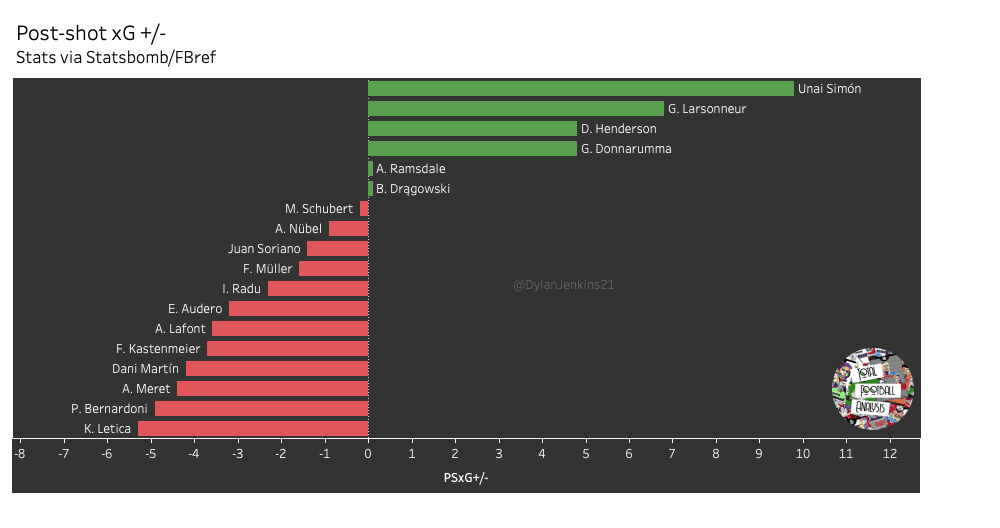
As we can see from the above graph, Donnarumma was in the top four when it came to goal-preventing performances. He has the same statistics as Manchester United goalkeeper Dean Henderson. Both saved 4.8 more goals than they were expecting to, meaning they over-performed massively.
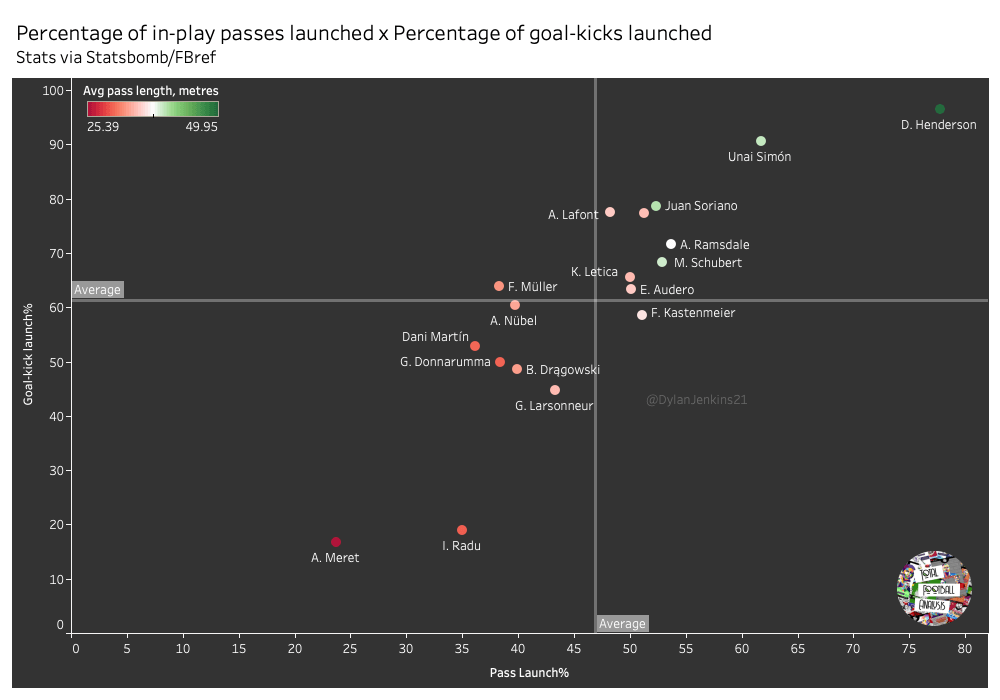
Donnarumma has been criticised for his passing since his debut, but this graph shows that he has improved in this area. Donnarumma has below-average stats in both goal-kick launch percentage and pass launch percentage. He launches 38.4% of his passes and 50% of his goal-kick, showing he has a good range of passing. This is mainly down to his team’s passing tactics.
Incredibly mature shot-stopping and anticipation
Standing at 6’5” already has a huge frame at the age of 21, he’s also bulked up since his debut and now weighs 198 pounds. However, his rather big frame doesn’t affect his nimbleness and reflexes, as he’s proven to be one of the best shot-stoppers in Europe. The Italian international boasts a 71.62% save percentage from 3.89 shots per 90.
One of his best attributes in this area is his low starting position. Given that he’s so tall, Donnarumma must have a good starting position to make saves low to the ground, because otherwise, he wouldn’t have enough time to get his body down to the floor. This, joined with his great anticipation means that he often saves extremely difficult shots.

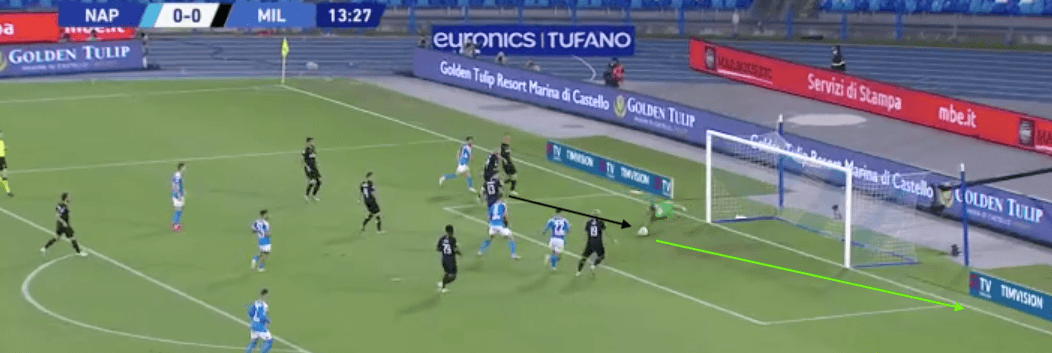
In the above example, against Napoli, we can see that as Dries Mertens advances towards the goal, Donnarumma sets himself in a low position. From this position, he can safely guard his near post, while also limiting the amount of goal that Mertens can see. He forces the Napoli man to shoot across his goal, which Donnarumma anticipates. Enabling him to make a terrific low save, pushing the ball away to safety. His low starting position here means that he’s able to get his body down to the floor as fast as possible.
However, a top-class goalkeeper needs both good positioning and reflexes. Luckily, Donnarumma has both.
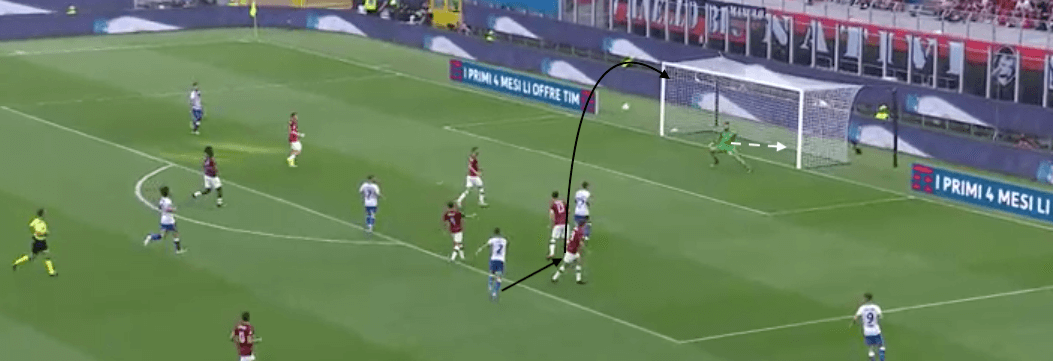
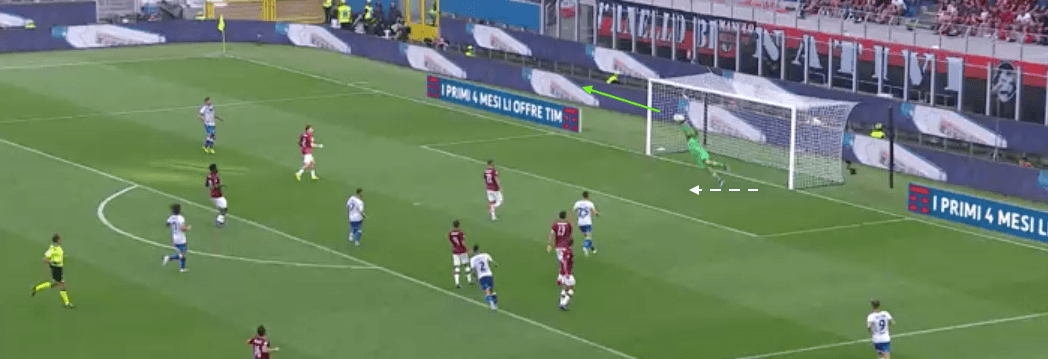
Here, we see an example of a terrific reflex save he makes during a crucial period of the game. As the initial shot is struck, Donnarumma has already set his position to comfortably save the shot. However, at the last minute the ball takes a deflection off a defender and suddenly moves in the opposite direction. As we can see in the first image, all of the keeper’s momentum is going towards the left, meaning he has to rely on his reach and height to then protect the other side of the goal. Donnarumma makes an excellent reflex save here, at full stretch.
Another area of goalkeeping where the Italian excels is his defence during one-on-one situations. He always has the composure to stay close to his goal to allow his defenders to apply pressure to the shooter. Other goalkeepers often lack this composure, leading them to make rash decisions.
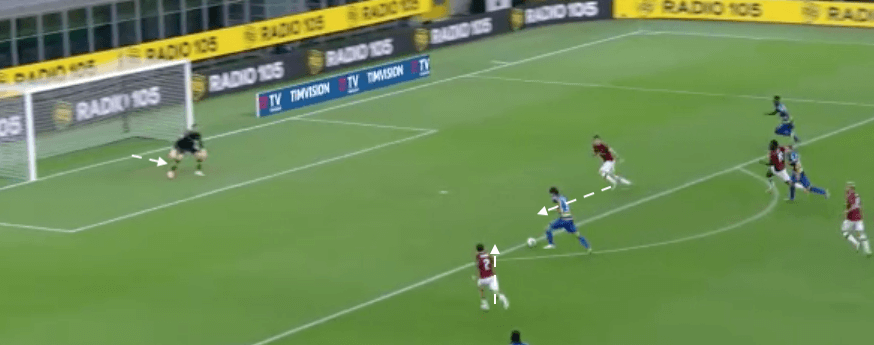
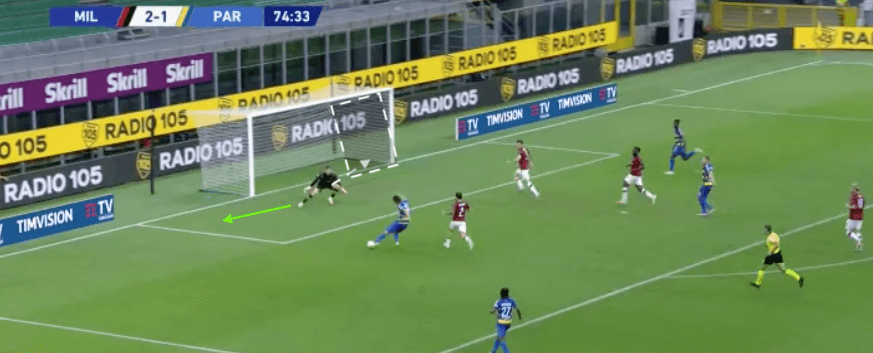
During one-on-one situations, Donnarumma has a tendency to rely on his big frame to save close to his goal, rather than rushing out towards his opponent and risk getting chipped. Here, against Parma, he allows his defenders to apply pressure to the attacker, effecting his end product. Donnarumma advances, but not too far. We can see his body position in the second image is covering a large amount of the goal, with the attacker needing to put it in the far right corner to ensure a goal. In this example, he ends up saving the shot with his legs.
The 21-year-old also has 1.81 exits per 90, which is one of the highest in the league. This means that he does leave his goal-line to close down attackers when needed. But he is very good at deciding how to deal with one-on-one situations. When the ball is more central, this is when Donnarumma tends to close the attacker down.
The AC Milan keeper has a great ability to save penalties, which is not very common for modern-day goalkeepers. This may be partially down to his work with his goalkeeper coach, joined with his big frame. During the 2019/20 season, Donnarumma saved 50% of the penalties that he faced. He faced 10 penalties in total.

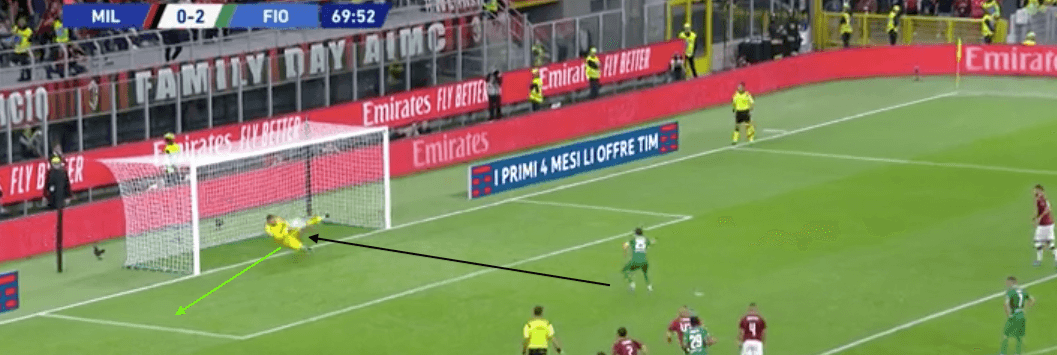
In the above example, we can see that he has already chosen which way he is going to dive before the attacker has even kicked the ball. This gives him an advantage of covering more of the goal. When he dives the correct way, his height and early movement mean that he will more than likely save the penalty. This is a huge ability for a goalkeeper to have.
Here is how Donnarumma compares to Wojciech Szczęsny in terms of goalkeeping abilities. We have chosen the Juventus goalkeeper because he plays for the best team in Serie A, so it would make for a clearer understanding of Donnarumma’s stats.
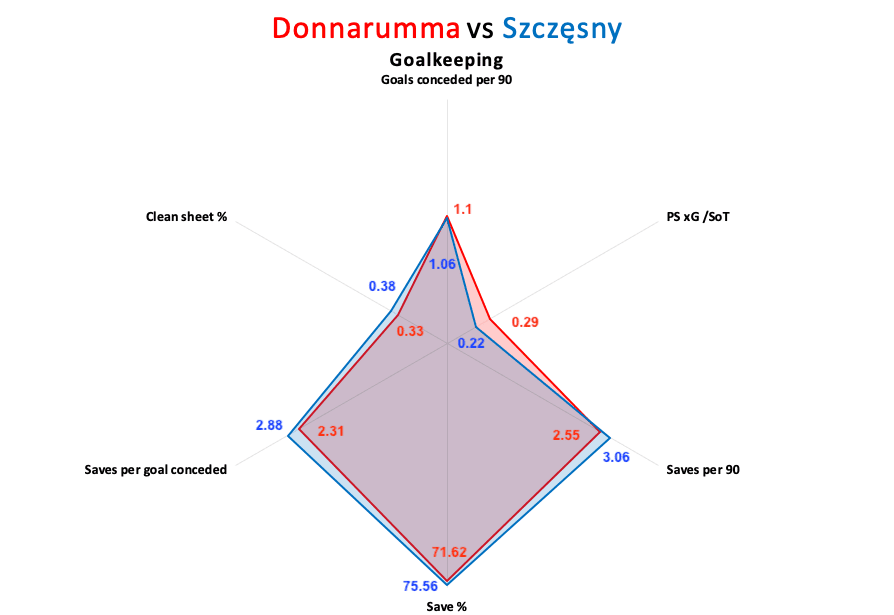
Donnarumma hasn’t performed as well as Szczęsny this season, but this is definitely because the latter plays behind a much stronger defence. The Milan man faces much harder shots than Szczęsny, with a PS xG /SoT value of 0.29, compared to Szczęsny’s 0.22.
Leadership within his box
Donnarumma is one of the most commanding young goalkeepers within the top five leagues. His size and confidence mean that he’s very effective and coming off his line and dealing with crosses and set-pieces. Here’s how he compares to his peers:
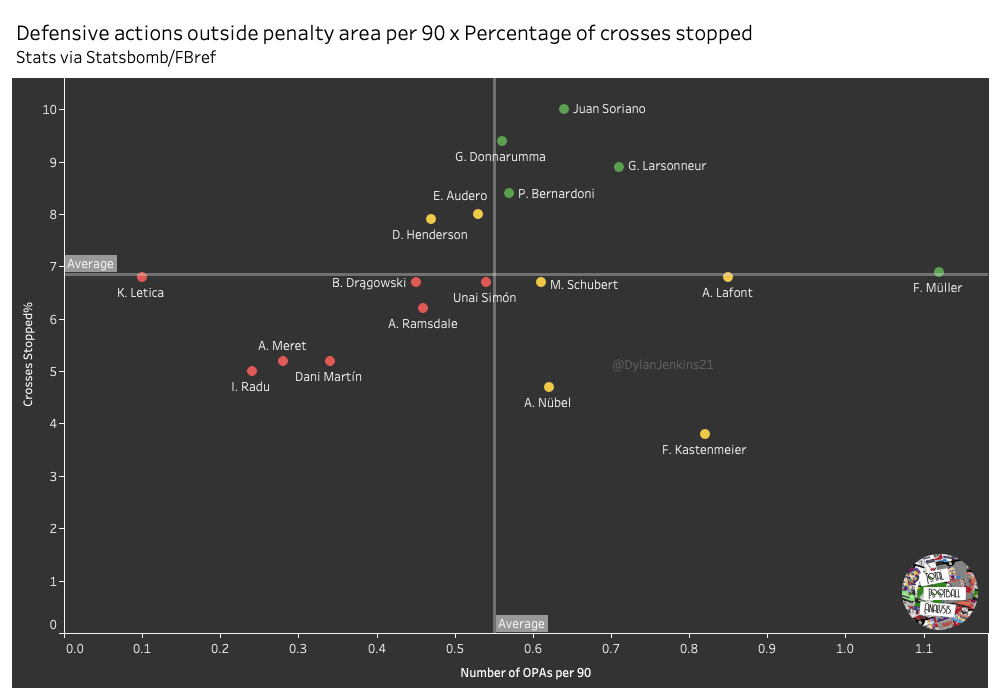
Here, when comparing each keeper’s OPAs per 90 and percentage of crosses stopped, we can see that Donnarumma is above-average in both. He makes 0.56 OPAs per 90 and stops a huge 9.4% of crosses he’s faced.
The Italian goes to tremendous lengths the take pressure off his defence and prevent dangerous crosses for his team.
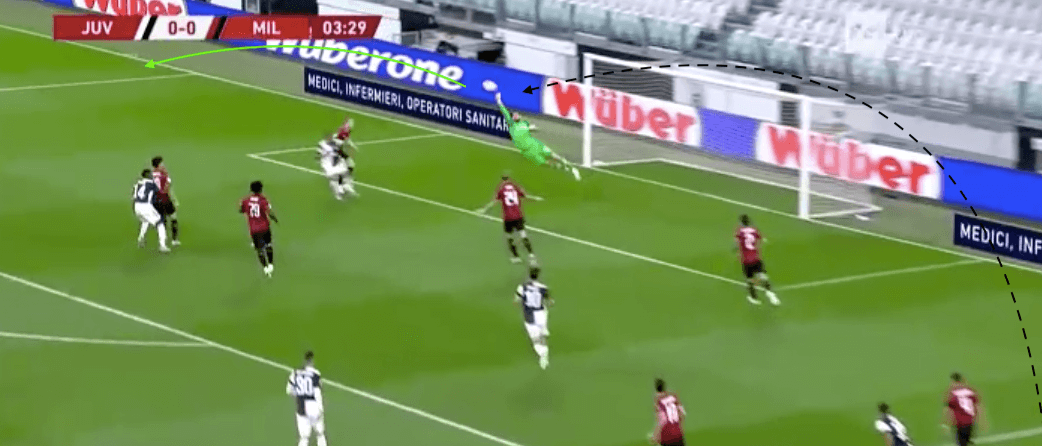
After a dangerous cross from Juventus’ Cristiano Ronaldo, destined for his teammates head, Donnarumma throws himself at the ball. He uses all his height and reach to prevent a guaranteed goal. This is a great example of how his confidence to leave his line is incredibly important for his team. He stops the ball similar to a save, even if he just gets fingertips to the ball it’s likely to put the attacker off.
This is an extreme example of his cross stopping abilities. He often claims crosses when they are closer to his goal and not as dangerous. He makes 0.42 punches per 90 and 0.92 claims per 90, meaning he prefers to catch the ball when possible. But his number of punches shows that he has the intelligence to know when he can catch and when he can’t.
Passing has been a weakness since the start
Although Donnarumma has a very good passing range, and also respectable stats, he does struggle to produce good passes under pressure. He makes 19.59 passes per 90 and has completed 87.94% of them. The 21-year-old has had many critics when it comes to his passing, and it doesn’t seem to have improved since his debut.
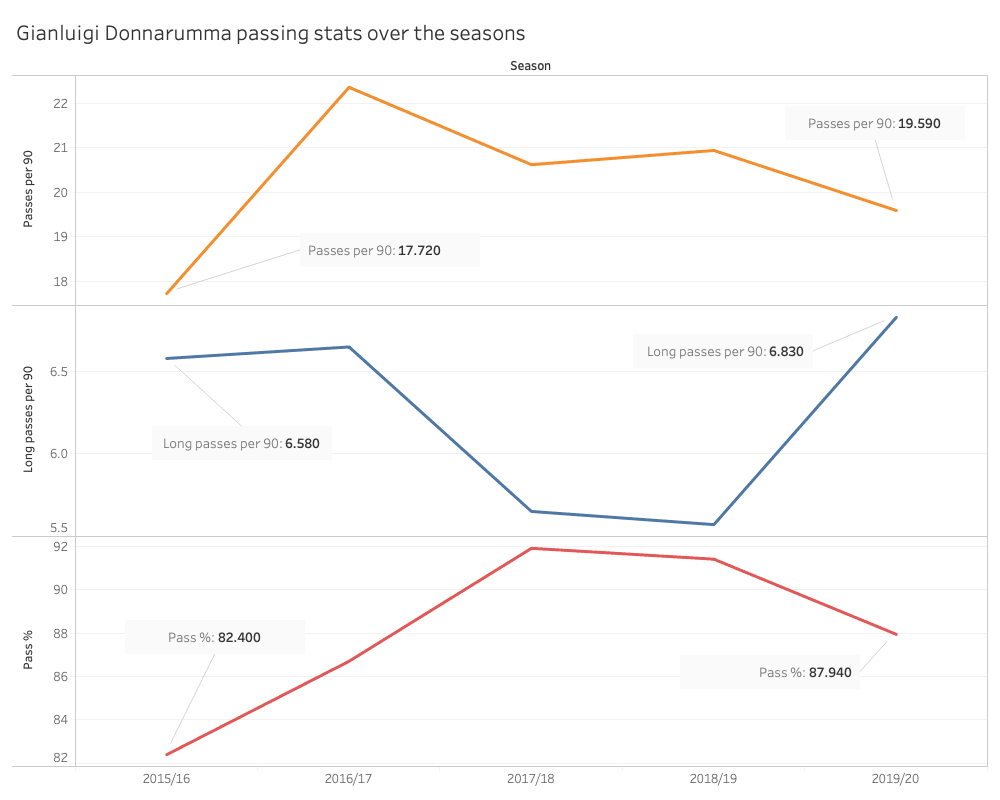
Although he is making more passes than when he first started out, the number per 90 has fallen over the past four seasons. He’s also making more long passes per 90 than when he started out. This can be put down to his lack of confidence when being confronted by opposition players. However, his passing accuracy has improved, meaning he is somewhat progressing.
When Donnarumma has time and space, however, he is very good at picking out inch-perfect passes. His vision and chipped pass technique often help his team advance up the pitch.
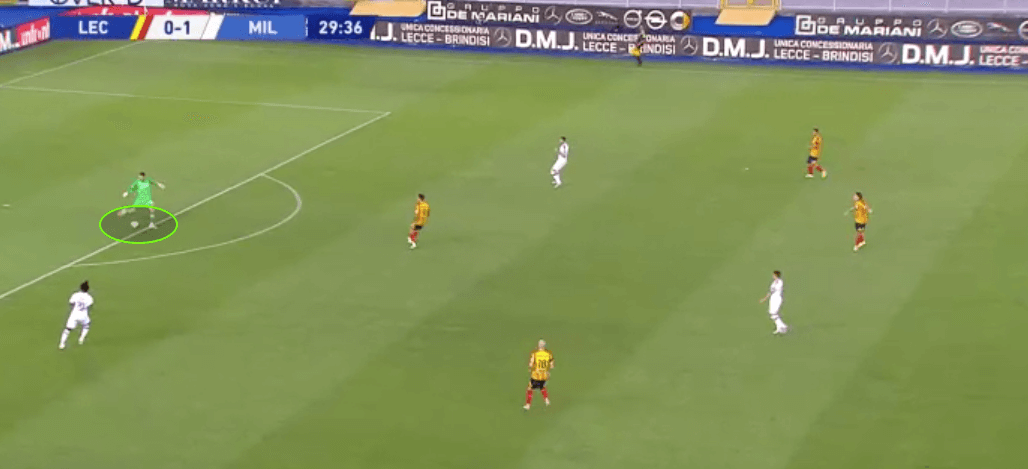
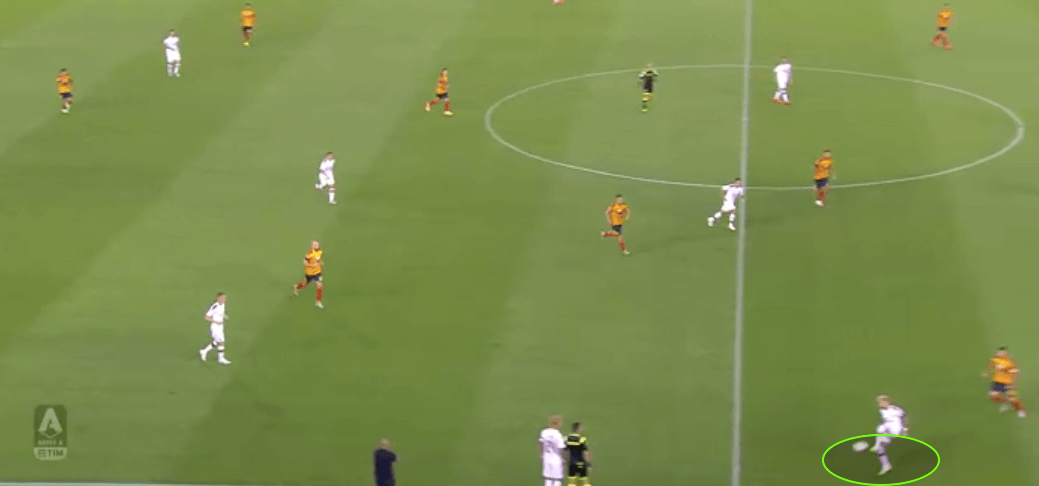
Here, when he receives the ball on the edge of his box, he’s able to get his head up and find an open teammate, because he isn’t being pressured by the opposition. He chips the ball with an adequate amount of power that it lands straight at the receiver’s feet.
This is certainly an area that Donnarumma needs to improve in if he is to play for a team that looks to play out from the back. Here is how he compares to Szczęsny:
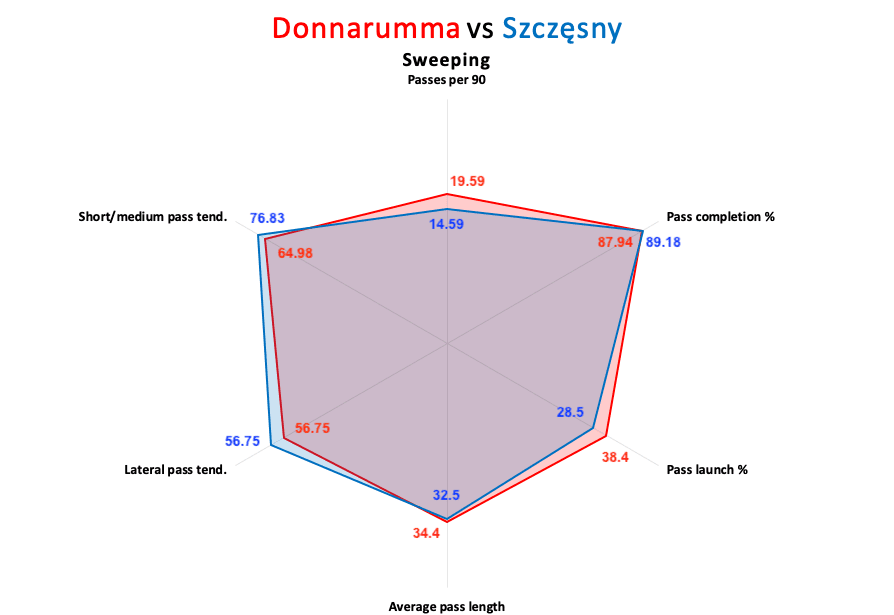
Although Donnarumma sees more of the ball than Szczęsny, he has a higher tendency to launch the pass, with a lower pass success percentage. Szczęsny is also more likely to make a short/medium pass and lateral passes.
Conclusion
This scout report has shown why Donnarumma is the best young goalkeeper. His shot-stopping is incredibly mature for his age. He is able to anticipate shots, allowing him to make saves that he isn’t expected to. This, along with his ability to command his area and take pressure off his defence would be a huge asset for any team.
His only weakness is his passing. And with many of the better European teams preferring to build from the back, this is a crucial area for the Italian to improve in if he wants to attract more interest. Donnarumma could benefit from another season with AC Milan before moving on to one of Europe’s elite.




Comments